If you were in the press room and were watching all the photographers ingest their images, write captions, crop and upload their images to the wire services or newspapers you would find the majority of them using PhotoMechanic. It sells for $150 and works on PC or Mac.
Why PhotoMechanic?
The number one reason most use it is speed. It is a stand alone image browser that is so fast for the pressroom most who use it in their workflow ingest into this program and if they need to more than crop their images then they may use PhotoShop or Lightroom to adjust color, burn and dodge or some other image correction.
Many photographers shooting on deadline shoot JPEGs for speed. Some will shoot JPEGs plus RAW and use the RAW to help salvage an image if necessary. You see most of these pros are nailing the exposure, focus and white balance. The most they are doing is cropping or rotating an image.
 |
| Figure 1 |
PhotoMechanic allows you to ingest multiple cards at one time. In Figure 1 you can see the screen that lets you customize how you ingest. I select the cards and then select a destination, which for me is always an external drive. I have it checked that when it is done to eject the cards and only to ingest new images.
Two more things I do before clicking the "Ingest" button is click the renaming of files. Now once this is done the next time I ingest this will be the same. By the way I rename all my images using this code "{year4}-{month}-{day0} {hour24}-{minute}-{second}."
The most important step to me that makes this program stand out is the ability to embed text into every image as I ingest.
 |
| Figure 2 |
Once I finish this I ingest. This will put the same IPTC on every image. This way when I want to modify the IPTC I only need to change a few things rather than put everything in the form from scratch.
Step Two—First Edit
I really don't want all the images I just ingested, so I am going to select the ones I want to keep first.
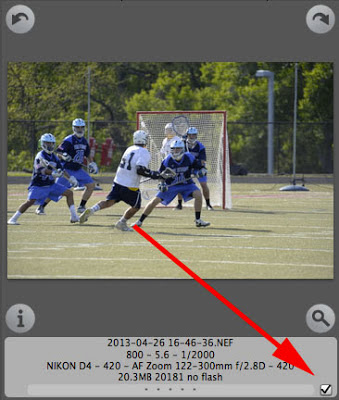 |
| Figure 3 |
 |
| Figure 4 |
Step Three—Rating
PhotoMechanic lets you rate images using color code system and/or stars. I primarily use the stars since this is how I was marking my contact sheets back in the days of film.
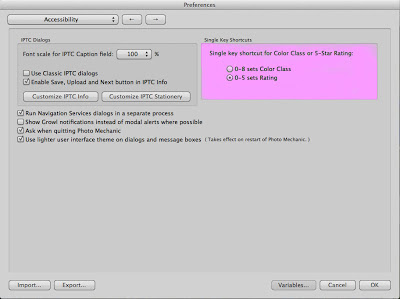 |
| Figure 5 |
Step Four—Caption Modification
Now I go to the bottom right hand corner of PhotoMechanics contact sheet and click how many "Stars" I want to show to help me narrow down the images I will transmit to the publication or wire service.
 |
| Figure 6 |
Now I can go into each photo and customize the caption. Now the really cool thing about PhotoMechanic is saving you key strokes and helping you be accurate with spelling. This is called "Code Replacement" in PM.
Go to Edit>Settings>Set Code Replacements and here you will select a TXT file that has been previously created. This will have the roster of the players for both teams.
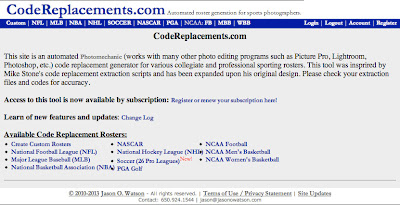 |
| Figure 7 |
Step Five—Image Correction if Needed
Sometimes you might need to do some work on the image. Here the photographer can press "⌘ Command" and "E" if they have selected an editing program like PhotoShop to make changes to an image or images.
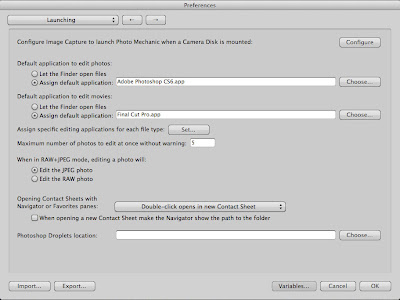 |
| Figure 8 |
Step Six—Upload for Deadline
Now you need to upload these images. Here is what I am doing for Associated Press. I have all the ftp information stored in PM and so I just select all the images, right click and click on "Upload."
 |
| Figure 9 |
Step Six—Keywording When not on Deadline
For when I am shooting for something other than deadline I am often keywording images.
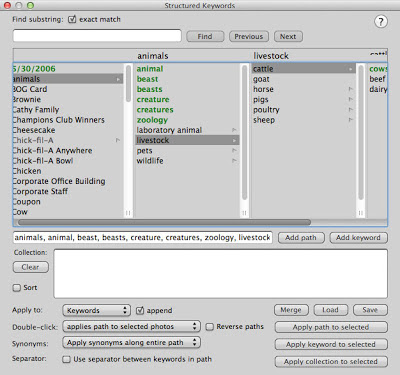 |
| Figure 10 |
So you can select one or multiple images and then just type "⌘ Command" and "I", which brings up the IPTC pad [figure 2] and then click on the pull down menu for Keywords see Figure 11.
 |
| Figure 11 |
Step Six—Upload to PhotoShelter or Stock Agency
 |
| Figure 12 |
Stanley's Workflow
- Ingest to PhotoMechanic
- Select the keepers
- Delete all untagged images
- Import into Lightroom, because I am shooting RAW
- Make all corrections necessary to images
- Export all images to sRGB JPEGs
- Open PM
- Upload if necessary
- Burn DVD as needed


6 comments:
I like your workflow but would like to offer a tip I've found very useful. For step three use "Color Class" instead of the rating system. This has multiple benefits; it allows you more variables in tagging, 8 color classes as apposed to 5 stars. You can also change the naming convention of the default Color Class labels (General Preferences) . This is incredible efficient way of providing generic metadata key-wording to help in cataloging for a DAM system.
I use terms like, "Released" "Hold" "TopShot" and "emailed" this is very useful if you have a large set of images that you need to search through. For example I can search all photos with the term "Released" in 2012 OR all "TopShot" in my archive.
Of course you will need a good DAM software solution - I use portfolio but I believe most and maybe even Apples Spotlight will index the metadata. AND since you're "key-wording" with the Color Class it's a quick and easy since you're using hot keys.
Shawn
That is the beauty of PM, you can customize it to your workflow.
I use Cumulus for my DAM catalogue.
I use PhotoMechanic 5 as a sports and editorial photograher and find it easy and fast to use,especially when captioning.
Thank you for the info, I've heard of colleagues using PhotoMechanic.
I shoot RAW and basic JPG (usually not for a deadline), and I'm always searching for a faster way to delete missed shots before backing up.
I like ACDSee because it's damn fast in opening the JPG, but if you hit DEL, it leaves back the RAW file.
I recently tried Lightroom; it's ok because when you delete a photo, it deletes both the JPG and the RAW, but for every file it opens the RAW, and it just takes too long to scroll through the images! Moreover it asks one more delete confirmation when I use my NAS, and that's a useless click.
Does PM deletes JPG and NEF in a single click? Does it shows you the JPG only when browsing?
You can do both or one. You can customize in preferences.
Thank you Stanley, I will keep this program in consideration.
Post a Comment